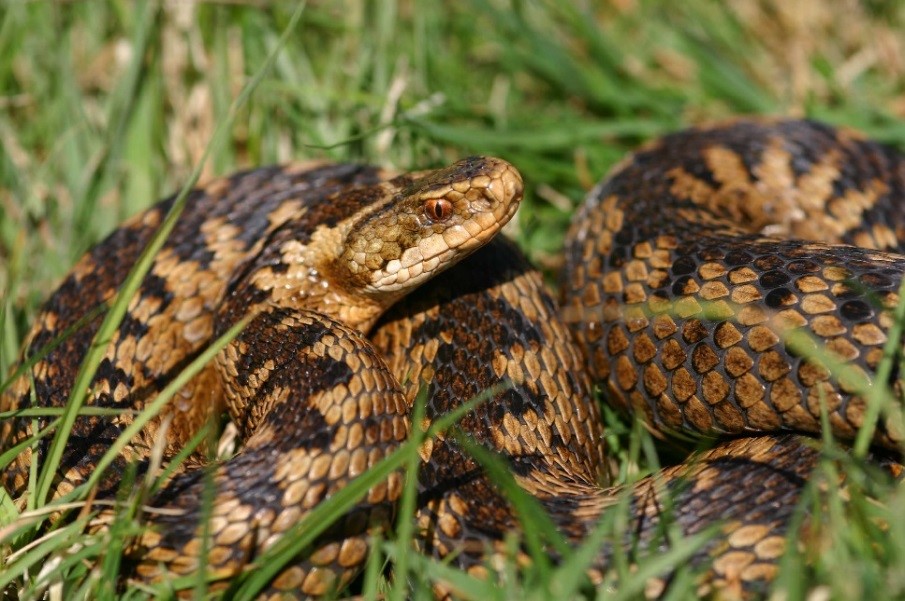European adder – a valuable contribution to Britain’s National Parks
20 August 2018
In their second article for our #summerofbeauty, Froglife provide a guide to the UK’s only venomous snake!
Walking along a bright, sunlit track in the Yorkshire Dales National Park on a warm May evening, I was surprised to spot a female adder basking in the sunshine. She was lying in the middle of the track, absolutely still, body pressed closely to the ground to absorb as much of the warmth as possible. As I approached she did not move and only the occasional flicking of the tongue revealed that she was still alert. Eventually she slithered off, silently into the undergrowth. This is often the only glimpse that people get of the adder, one of the most elusive and secretive snake species native to the UK. Here we find out more about these fascinating creatures.
What is an adder?
The adder (also known as northern viper) (Vipera berus) is one of three snake species native to the British Isles which also includes the more common grass snake (Natrix natrix) and rare smooth snake (Coronella austriaca). Adders are usually easy to recognise as they usually possess a dark zig-zag line which runs down the centre of their backs. They are the only venomous snake in the UK, but bites to humans are rare.

An adder basking in the sun. Photo credit: Matt Wilson
What is the life cycle of an adder?
Adders emerge from their long winter hibernation in March and spend the next few weeks basking in the warm early spring sunshine. They remain close to their hibernacula which are often raised, dry, south-facing banks. It is during this period that adders are easiest to spot and approach since they remain in a relatively inactive state.
After this period adders become increasingly difficult to find since males may travel 200 metres a day, following the scent trails left by females. After vigorous courtship, both males and females move to summer foraging areas where they may travel widely in search of prey, which are typically small mammals such as voles and mice, but they will also take nestling birds, frogs and other amphibians. Adders give birth relatively late in the year and females will return to their hibernation areas in August and early September to give birth to between three and 18 young. Since females breed so late in the year, adders typically only breed once every two years. Upon hatching juvenile adders do not feed, but grow using stored yolk. It is not until after the winter hibernation that juveniles take their first food.
In which National Parks do adders occur?
Adders tend to favour undisturbed ground so are less commonly observed nea r to human habitation. Favoured habitats include heathland, moorland, chalk downlands, woodland rides and also on coastal dunes and cliff tops.
r to human habitation. Favoured habitats include heathland, moorland, chalk downlands, woodland rides and also on coastal dunes and cliff tops.
Within the UK, adders occur in seven of the 15 National Parks including the Cairngorms, Exmoor, North York Moors and South Downs.
Within these National Parks, adders typically occur in the dry, heathland areas. In particular, adders favour undisturbed sunny areas, often on south-facing slopes, which are also close to dense vegetation (Figure 2). They tend to avoid heavy clay soils, instead preferring lighter soils such as chalk or sand. However, you may also find adders in damp areas surrounding ponds, lakes and bogs, where they can often be found basking. Habitats which contain grassland and heath with a variety of sward heights are also favoured.

Ideal adder habitat. Photo credit: Froglife
Are adders harmful to humans?
Being the UK’s only venomous snake, adders have received more public attention than other reptile species. This publicity is usually unwarranted since snake bites to humans are still very rare and of reported cases, 70% of bites result in no venom being injected. Of those cases where venom has entered the bloodstream, localised swelling around the site of the bite is usually the main symptom. There have been no reported human fatalities as a result of an adder bite over the past 40 years.
Why are adders in decline?
Nationally, adder populations are in decline due to a combination of factors, but habitat loss and fragmentation are the main contributors. This has resulted in many populations becoming isolated due to an inability of adders to disperse between areas of suitable habitat. Human barriers such as roads, housing and industrial developments have all contributed to population isolation.
Although many populations of adders within the National Parks receive greater habitat preservation compared to other areas of the country, they are still prone to increased public disturbance (e.g. tourism) and persecution in these areas. Therefore, conservation of the adder requires a combination of provision of suitable habitat, increased connectivity in the form of wildlife corridors and a reduction in human disturbance.
By Dr. Laurence Jarvis
Science and Research Manager at Froglife

